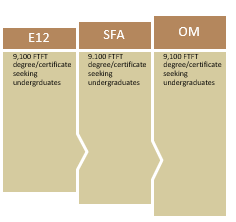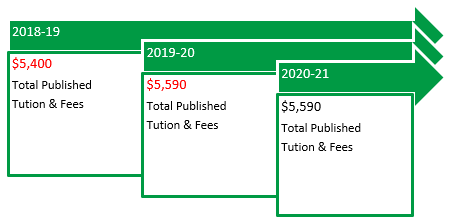Appendix C - IPEDS New Keyholder Handbook 2022-23
Appendix C - IPEDS 2023-24 Keyholder Handbook v31.docx
Integrated Postsecondary Education Data System (IPEDS) 2022-23 through 2024-25
Appendix C - IPEDS New Keyholder Handbook 2022-23
OMB: 1850-0582
Integrated Postsecondary Education Data System (IPEDS) 2022-23 through 2024-25
Appendix C
IPEDS 2023-24 Keyholder Handbook
OMB No. 1850-0582 v.31
Submitted by:
National Center for Education Statistics (NCES)
Institute of Education Sciences
U.S. Department of Education
February 2022
revised July 2023
|
Integrated Postsecondary Education Data System |
Keyholder Handbook 2023 – 24 |
|
|
U.S. DEPARTMENT OF EDUCATION |
|
|
N |
|
 Preface
Preface
This handbook provides a guide and selected reference materials for keyholders for submitting data to the Integrated Postsecondary Education Data System (IPEDS), administered by the National Center for Education Statistics (NCES). It includes a general description of IPEDS, the collection schedule, and other materials and resources to assist new and experienced keyholders with planning to compile and report IPEDS data.
This document was prepared by the IPEDS staff at NCES. Comments, questions, or requests for additional information should be directed to:
Aida Ali-Akreyi, Ph.D.
Operations Lead
Administrative Data Division
National Center for Education Statistics
Institute of Education Sciences
IPEDS Keyholder Handbook
Overview of the Integrated Postsecondary Education Data System (IPEDS) 6
Importance of the Keyholder’s Job 8
Description of IPEDS Survey Components and Data 10
Getting Ready for Data Submission 16
Important concepts and tips 24
Using the IPEDS Data Collection System 27
Tips from Veteran Keyholders and the IPEDS Help Desk 41
The National Center for Education Statistics (NCES), in the Institute of Education Sciences (IES), is the statistical agency of the U.S. Department of Education and the primary federal provider of education statistics on the condition of the U.S. postsecondary education. It is responsible for analysis and dissemination of all data collected through the Integrated Postsecondary Education Data System (IPEDS), in report format and through release of the data files in various formats. The IPEDS Help Desk staff assist IPEDS data providers with the use of the IPEDS web-based Data Collection System (DCS) and related issues. There is also an IPEDS Data Tools Help Desk, which assists data users on how to retrieve and analyze IPEDS data online.
Inquiries may be made to either NCES or to the IPEDS help desks, depending on the nature of the question. The table on the following page includes names, areas of responsibility, and contact information for NCES staff, including survey directors (some survey directors are contractors) as well as the IPEDS Help Desks.
IPEDS Directory |
||
Name |
Telephone/E-mail |
Areas of Responsibility |
Tara Lawley |
Branch Chief; IPEDS Program Director |
|
IPEDS Staff: IPEDS@ed.gov |
||
Aida Ali Akreyi |
Data collection: Operations Lead, Finance survey director |
|
Christopher Cody |
Data collection: Collection management; Academic Libraries and Human Resources |
|
Michelle Coon |
Data collection: Completions and Admissions Other: Classification of Instructional Programs |
|
Moussa Ezzeddine |
Data collection: Universe management; IC Header Other: File development, Crosswalks, Database |
|
Andrew Mary |
Data collection: Graduation Rates/Graduation Rates 200 Other: Contracts, Publications |
|
Stacey Peterson |
Data collection: Institutional Characteristics and Student Financial Aid |
|
McCall Pitcher |
Data collection: Outcome Measures |
|
Roman Ruiz |
Data collection: Fall and 12-month Enrollment |
|
IPEDS Help Desks (RTI, Inc.) |
||
Collection Data Use |
1-877-225-2568 ipedshelp@rti.org 1-866-558-0658 ipedstools@rti.org |
|
Overview of the Integrated Postsecondary Education Data System (IPEDS)
The
Integrated Postsecondary Education Data System, or IPEDS, is a
system of interrelated surveys
components
conducted annually by the U.S. Department of Education’s
National Center for Education Statistics (NCES). The survey
components gather information from every college, university, and
technical and vocational institution that participates in Title IV
federal student financial aid programs. The Higher Education Act of
1965 (HEA), as amended, requires that institutions that participate
in federal student aid programs report data on 6 areas:
Admissions;
Degrees and certificated conferred;
Enrollment;
Institutional Characteristics and Resources;
Institutional Prices and Student Financial Aid; and
Student Persistence and Success.
More information about the survey components covering each of these areas can be found at https://nces.ed.gov/ipeds/use-the-data/survey-components. These data are made available to students and parents through the IPEDS Find Your College webpage and the College Affordability and Transparency Center website, and to researchers and others through the IPEDS Use the Data webpage.
I PEDS
provides basic data needed to describe — and analyze trends in
— postsecondary education in the United States, in terms of
the numbers of students enrolled, financial aid used, staff
employed, dollars expended, and degrees and certificates earned.
Congress, federal agencies, state governments, education providers,
professional associations, private businesses, media, students,
parents, and others rely on IPEDS data for this basic information on
postsecondary institutions.
PEDS
provides basic data needed to describe — and analyze trends in
— postsecondary education in the United States, in terms of
the numbers of students enrolled, financial aid used, staff
employed, dollars expended, and degrees and certificates earned.
Congress, federal agencies, state governments, education providers,
professional associations, private businesses, media, students,
parents, and others rely on IPEDS data for this basic information on
postsecondary institutions.
WHICH INSTITUTIONS MUST REPORT TO IPEDS?

34
CFR 668.14 (b)(19) reads:
…It
will complete, in a timely manner and to the satisfaction of the
Secretary, surveys conducted as a part of the Integrated
Postsecondary Education Data System (IPEDS) or any other Federal
collection effort, as designated by the Secretary, regarding data
on postsecondary institutions…
s
components
is mandatory for institutions that participate in or are applicants
for participation in any federal student financial aid program (such
as Pell grants and federal student loans) authorized by Title IV of
the Higher Education Act of 1965, as amended (20 USC 1094, Section
487(a)(17) and 34 CFR 668.14(b)(19)).
More than 6,000 institutions complete IPEDS surveys each year. These include research universities, state colleges and universities, private religious and liberal arts colleges, for-profit institutions, community and technical colleges, non-degree-granting institutions such as beauty colleges, and others. Some institutions voluntarily submit data to IPEDS even though they do not participate in Title IV programs.
Importance of the Keyholder’s Job
As an IPEDS keyholder, responsible for the submission of all IPEDS data for your institution, you have an important job. The quality and accuracy of your institution’s IPEDS data depend on you.
T he
completion of all IPEDS survey
he
completion of all IPEDS surveys
components,
in a timely and accurate manner, is mandatory for all institutions
that participate in or are applicants for participation in any
Federal financial assistance program authorized by Title IV of the
Higher Education Act of 1965. Submitting IPEDS data accurately and
on time ensures that your institution will meet its Program
Participation Agreement for participation in Title IV federal
student financial aid programs with the U.S. Department of
Education. In this way, your institution will avoid fines and other
possible penalties for noncompliance with IPEDS reporting
requirements.
IPEDS data are a public face of your institution. They are used by students and parents, through the College Navigator webpage and College Affordability and Transparency Center website, to aid in the college search process; at the federal, state, and local level for policy analysis and development; by institutions for benchmarking and peer analysis; and by professional associations, private businesses, and the media.

College Navigator is a consumer information and college search tool. It was designed to help college students, prospective students, and their parents understand the differences between colleges and how much it costs to attend college. Most of the data displayed on College Navigator is submitted through IPEDS. Users can select colleges based on location, programs, degree offerings, and a number of other characteristics, and obtain information on admissions, estimated student expenses, student financial aid awarded, retention and graduation rates, enrollment, completions, accreditation status, campus security, varsity athletic teams, and military students. It allows users to designate favorite institutions, compare up to four institutions side-by-side, save sessions, and download and print out information on institutions.
The College Affordability and Transparency Center houses the College Scorecard, which displays information about tuition and net prices at postsecondary institutions. The site highlights institutions with high and low tuition and fees as well as high and low net prices (the price of attendance minus grant and scholarship aid). It also shows institutions where tuition and fees and net prices are increasing at the highest rates. The College Scorecard and lists of institutions are both based on the IPEDS data you submit.
![]()
As potential students apply for financial aid, they can see tuition and fees, average net price, graduation rates, retention rates, and transfer rates for schools they are interested in attending.

IPEDS data are used at the Federal, state, and local levels for policy analysis and development.
 Each
winter, you and your institution’s Chief Executive Officer
receive a copy of your institution’s personalized IPEDS
Data Feedback Report.
This report uses graphs to compare your institution’s data for
selected items to data reported by a group of comparison
institutions. The result is an annual report that is hopefully
useful to institutional executives and institutions for benchmarking
and peer analysis, and that can help improve the quality and
comparability of IPEDS data. The Portable Document Format (PDF) and
HyperText Markup Language (HTML) versions of the reports are
available to institutions and the public from the IPEDS Use the Data
webpage.
Each
winter, you and your institution’s Chief Executive Officer
receive a copy of your institution’s personalized IPEDS
Data Feedback Report.
This report uses graphs to compare your institution’s data for
selected items to data reported by a group of comparison
institutions. The result is an annual report that is hopefully
useful to institutional executives and institutions for benchmarking
and peer analysis, and that can help improve the quality and
comparability of IPEDS data. The Portable Document Format (PDF) and
HyperText Markup Language (HTML) versions of the reports are
available to institutions and the public from the IPEDS Use the Data
webpage.

IPEDS data are released by NCES in Web Tables and are used in the annual Digest of Education Statistics and The Condition of Education reports.
F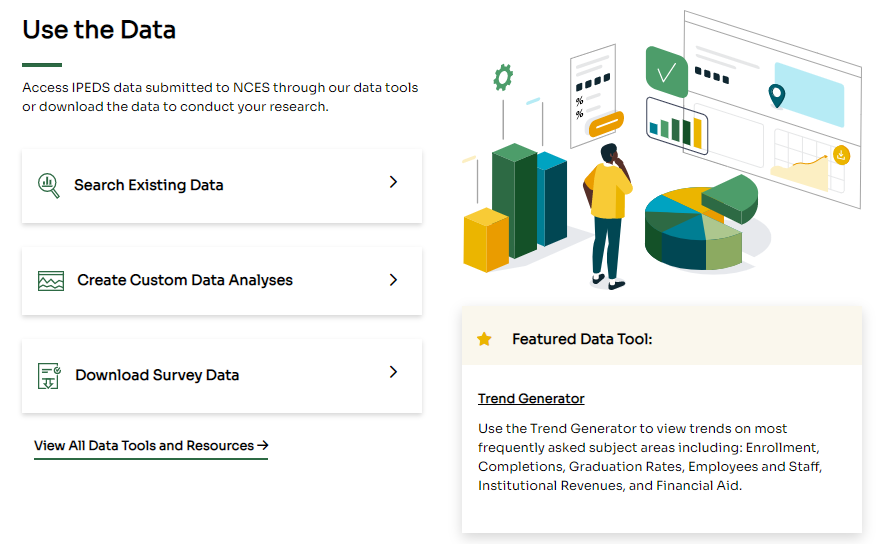 inally,
IPEDS data are used by institutions, researchers, education
providers, professional associations, private businesses, the media,
and many others through the IPEDS
Use the Data webpage.
inally,
IPEDS data are used by institutions, researchers, education
providers, professional associations, private businesses, the media,
and many others through the IPEDS
Use the Data webpage.
AM I A KEYHOLDER? Keyholders
have a lot of responsibility – so make sure that if you are a
keyholder you know it! Keyholders have been assigned by the Chief
Executive of their institution as the point of contact for IPEDS.
Keyholder UnitIDs start with P or 88G. If you remain confused as to
whether or not you are the Keyholder – contact the IPEDS Help
Desk (ipedshelp@rti.org;
877.225.2568)

Description of IPEDS Survey Components and Data
The following pages list the IPEDS survey components and the data collected by each.
Institutions are required to submit data for all survey components unless the data do not apply to them. For example, if an institution admits only graduate students, and therefore has no full-time, first-time degree-/certificate-seeking undergraduate students, the Graduation Rates (GR) and Graduation Rates 200% (GR200) survey components would not apply. The Data Collection System (DCS) will determine whether a survey component is applicable or not. If you have questions about this, contact the IPEDS Help Desk at 1-877-225-2568, or ipedshelp@rti.org.
Survey components are customized for each institution, based on institutional characteristics such as levels of program offerings (undergraduate, graduate) and institutional control (public, private not-for-profit, and private for-profit), and on answers provided by the keyholder to screening questions (for example, Does your institution employ part-time staff?).
IPEDS Survey Components |
|
Registration |
|
IC Header (IC-H) and Institutional Identification (ID) |
The Institutional Characteristics Header (IC-H) survey component collects basic institutional information and is used to identify other survey components the institution must complete. Data collected include:
IC-H also contains screening questions for other survey components. Open admission policy and library expenses (degree-granting institutions only) are some examples. |
IPEDS Survey Components |
|
Fall Data Collection |
|
12-month Enrollment (E12) |
The 12-month Enrollment (E12) data are collected for students enrolled in credit-bearing courses at the undergraduate and graduate levels. The 12-month reporting period is July 1-June 30. Data collected/calculated include:
Since FTEs represent an institution’s combined part-time and full-time enrollment, they are used to compare E12 across the institution types. They are also used to compute expenses by function per FTE and revenues per FTE, which are reported on the IPEDS Data Feedback Report. |
Completions (C) |
The Completions (C) data are collected for award levels ranging from subbaccalaureate certificates to doctoral degrees. Data collected include:
IPEDS also collects information on the number of students receiving degrees with double majors by 6-digit CIP code (for the second major) and by race/ethnicity and gender of recipient. |
Institutional Characteristics (IC) |
Data collected in the Institutional Characteristics (IC) survey component provide general information about the institution. Data collected include:
|
IPEDS Survey Components |
|
Spring Data Collection |
|
Academic Libraries (AL) |
The Academic Libraries (AL) survey component collects basic information on library collections/circulation, expenses, and services for degree-granting postsecondary institutions. Data collected include:
Institutions with annual library expenses less than $100,000 are only required to report collections information. |
Fall Enrollment (EF) |
The Fall Enrollment (EF) data are collected for all students enrolled in credit-bearing courses/programs which could potentially lead to awards ranging from subbaccalaureate certificates to doctoral degrees. Data collected include:
In even-numbered years, four-year institutions are also required to provide enrollment data by level, race/ethnicity, and gender for 9 selected fields of study for the Office for Civil Rights. |
Finance (F)
|
The Finance (F) survey component collects data related to the financial condition of the institution. Data collected include:
Different survey forms are used based on the institution’s accounting standards (GASB or FASB). |
Human Resources (HR)
|
The Human Resources (HR) survey component collects data on the number and type of staff supporting postsecondary education activities. Data collected include:
|
The primary responsibility of an IPEDS keyholder is to make sure all applicable survey components are submitted accurately and on time. This includes entering data into the web-based IPEDS Data Collection System (DCS), running the edits and resolving all edit issues and errors, and locking each survey component. All this must be completed by the time the data collection closes to keyholders.
Manage all aspects of data submission
In order to submit accurate data on time, you must manage all aspects of data submission for your institution, even if others on campus complete some survey components/assist by extracting the data from information systems. As keyholder, you are responsible for making sure the other offices have all the information and materials they need (blank forms, survey instructions, upload specifications, access to the glossary, etc.). You may also need to arrange for others to have access to the IPEDS DCS, by generating and issuing UserIDs and passwords.
Be the institutional point of contact
You must register in the IPEDS DCS and keep your contact information current at all times. As the keyholder, you are the institutional point of contact with NCES, and you will be contacted if the Help Desk or survey directors have questions about your institution’s data. You will also receive all prompting emails and other important notices sent out during the data collection periods.
Work with your state and system
Many states/systems have IPEDS coordinators (this is a separate role with a later deadline – keyholders at institutions must ALWAYS report by the keyholder deadline) who are responsible for state- or system-level coordination of IPEDS submissions. Coordinator roles vary from state to state and system to system. If your institution is coordinated at one of these levels, it is your responsibility to know how your role intersects with the coordinator’s role in the data submission process. Also, it is your responsibility to communicate with state/system coordinators concerning shared responsibilities for data submission and timing of data submission; some states/systems submit data for institutions from their own information systems, relieving institutions of some of the burden for reporting directly to IPEDS. Coordinators may have different due dates for data submission that are not reflected in the federal IPEDS due dates.
There are several ways to get IPEDS news and updates. NCES sends out information regularly through the following:
This Week in IPEDS at: https://nces.ed.gov/ipeds/this-week-in-ipeds
IPEDS on Twitter at: IPEDS (@ipeds_nces) / Twitter or https://twitter.com/ipeds_nces
The IES Newsflash email alert system at: https://ies.ed.gov/newsflash/
The updates contain important and useful information, including information on training opportunities. You can also learn from your colleagues on the IPEDS Knowledge Exchange at https://www.airweb.org/collaborate-learn/ipeds/ipeds-community.
Since you are responsible for making sure all IPEDS data are submitted for your institution, please remember to contact the Help Desk in the following situations:
If you do not receive a UserID and password every August;
If the list of applicable survey
scomponents in the DCS is not correct;If a survey component status is not correct;
If you have questions about survey instructions, glossary definitions, time periods for reporting;
If you have problems entering data;
If you have problems resolving edit failures;
If you have problems locking your data;
If you have questions concerning ANY follow-up email;
If you have any other questions about IPEDS data submission.
The IPEDS Help Desk receives high ratings from keyholders and coordinators for customer service, helpfulness, and knowledge of IPEDS. They are there to help you get your IPEDS data submitted accurately and on time.
The Help Desk contact information is at the top of each screen in the Data Collection System:

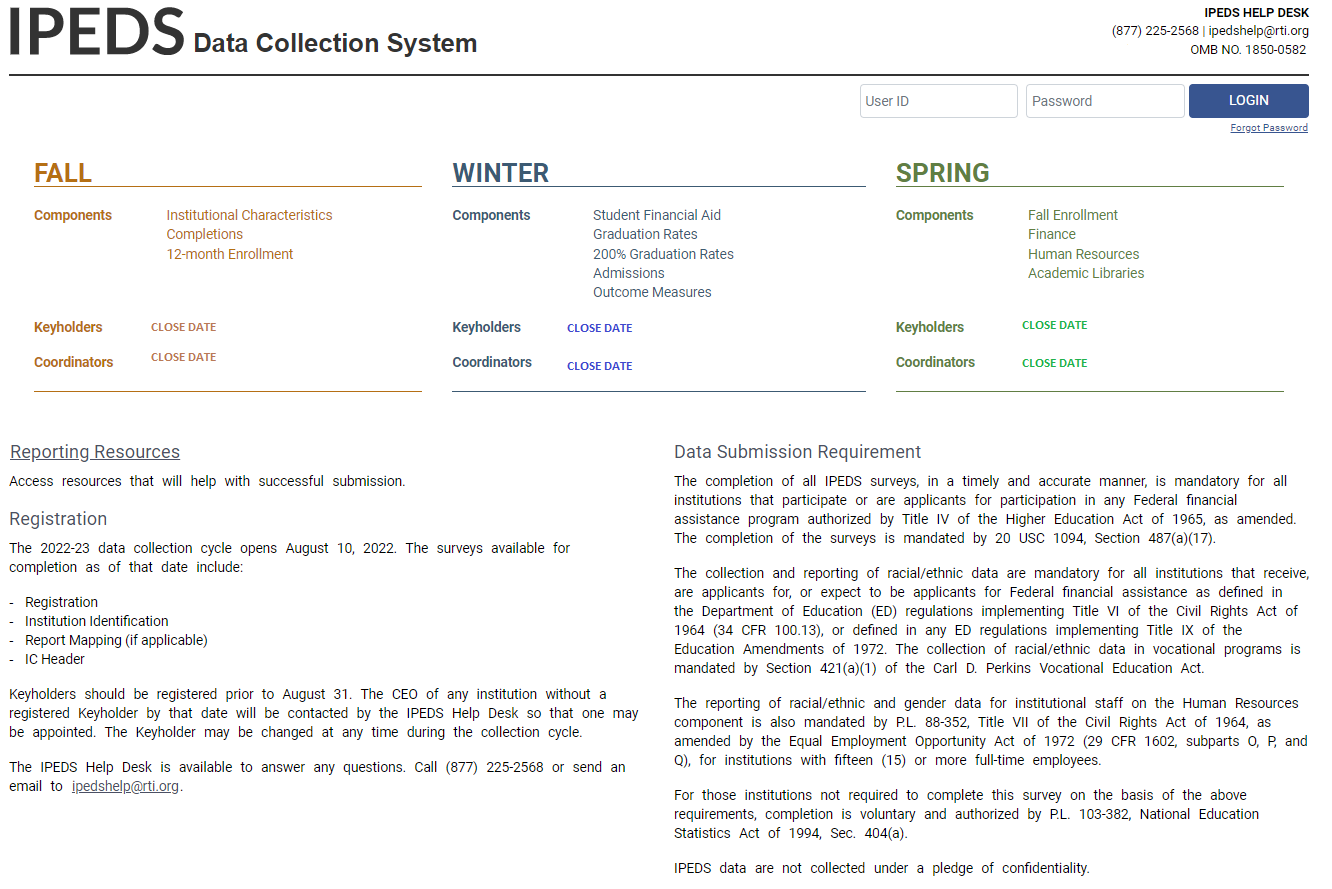
Getting Ready for Data Submission
T![]() he
first thing we suggest you do is to familiarize yourself with the
data collection schedule for the year. The 2023-24 submission
schedule is shown below. An electronic version is available on the
IPEDS ‘Report Your Data’ webpage.
he
first thing we suggest you do is to familiarize yourself with the
data collection schedule for the year. The 2023-24 submission
schedule is shown below. An electronic version is available on the
IPEDS ‘Report Your Data’ webpage.
IPEDS 2023-24 data collection schedule |
||||
2023-24 |
Registration |
Fall |
Winter |
Spring |
Collection Opens |
|
September 6 |
December 6 |
December 6 |
Collection Closes for Keyholders |
Register
by |
October 18 |
February 7 |
April 3 |
Collection Closes for Coordinators |
Register
by |
November 1 |
February 21 |
April 17 |
Components included |
Registration; |
Institutional
Characteristics (IC); |
Student
Financial Aid (SFA); |
Fall
Enrollment (EF); |
Provisional
Data |
|
Early summer |
Mid fall |
Late fall |
* Release dates are approximate. |
Prior Year Revision System Calendar
Data submitted by your institution last year (that is, during the 2022-23 data collection) can be revised as needed through the IPEDS Prior Year Revision (PYR) system. Components will be open for revision during their regular collection period except Fall, which opens one week later. For example, revisions to the 2022-23 Completions survey component can be made during the 2023-24 Fall collection period starting one week after the Fall collection period opens.
The PYR system can be found on the IPEDS Report Your Data webpage.
N![]() ext,
you’ll probably want to familiarize yourself with the survey
reporting requirements by reviewing
the survey materials for
the year, and by reviewing
the posted changes for
the collection. You can access the Login Page for the DCS from the
IPEDS homepage by clicking on Report Your Data.
ext,
you’ll probably want to familiarize yourself with the survey
reporting requirements by reviewing
the survey materials for
the year, and by reviewing
the posted changes for
the collection. You can access the Login Page for the DCS from the
IPEDS homepage by clicking on Report Your Data.

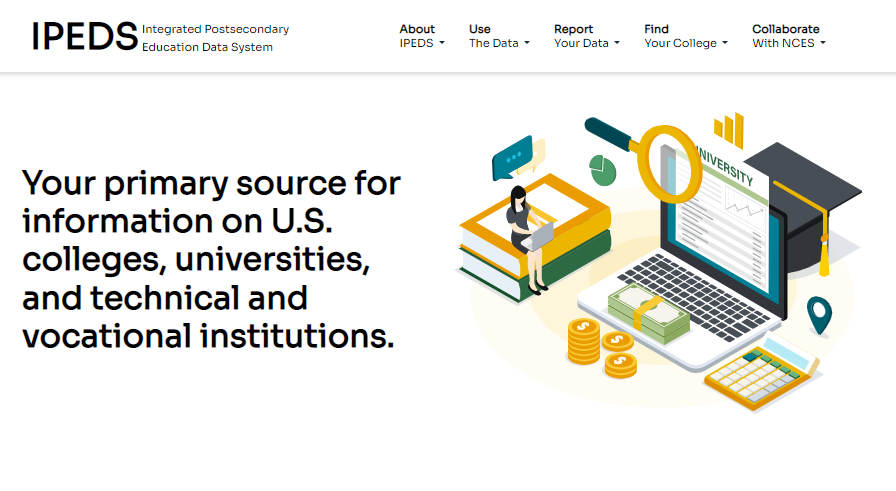
This will take you to the Report Your Data webpage below. Here you will find lots of helpful information, including links to the:
DCS to Answer the Current Survey,
Prior Year Revision System,
Collection Schedule and Survey Materials, and
Updates to the Data Collection.


When you click the Current Survey Materials link, answer a few questions on the screen to get a short list of surveys to choose from. Once you’ve completed your IC-Header survey component, you can search for your institution’s customized survey materials by entering your UnitID or institution name. Or, click View All at the bottom of the page to get the complete list of all survey component versions for all types of institutions.
Using the Survey Materials option, you can download and print blank survey forms, instructions, FAQs, and edit and import specifications, so that you can prepare your data for submission, and alert others at your institution to the data you’ll need them to provide to you for submission. The Package option puts all survey materials together in a PDF file for downloading.
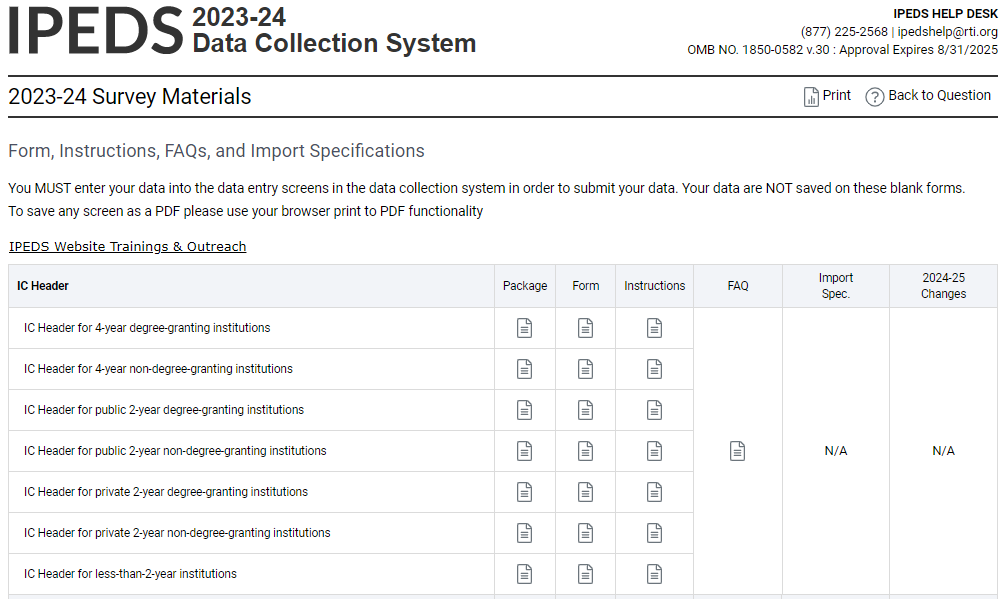

The Report Your Data webpage also includes helpful reporting guides and tools, as well as key information about the IPEDS data collection. This is also one place where you can find the IPEDS glossary.
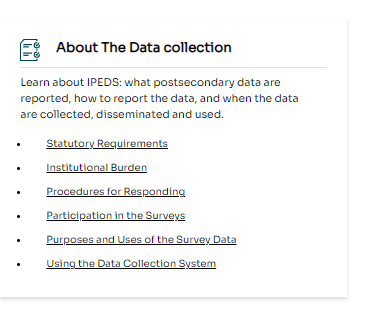



I![]() dentify
areas for further training. There are online tutorials available for
each survey component and one specifically for new keyholders. These
are free and posted on the IPEDS website under Trainings &
Outreach on the IPEDS
Collaborate with NCES webpage, so you can view them on your
schedule, when you have time. The survey component tutorials are
also available from the survey screens, so you can access this
“just-in-time” information as you’re submitting
your data.
dentify
areas for further training. There are online tutorials available for
each survey component and one specifically for new keyholders. These
are free and posted on the IPEDS website under Trainings &
Outreach on the IPEDS
Collaborate with NCES webpage, so you can view them on your
schedule, when you have time. The survey component tutorials are
also available from the survey screens, so you can access this
“just-in-time” information as you’re submitting
your data.

There are also face-to-face workshops around the country every year, which are announced in This Week in IPEDS and on Twitter. There are also two online courses for keyholders:
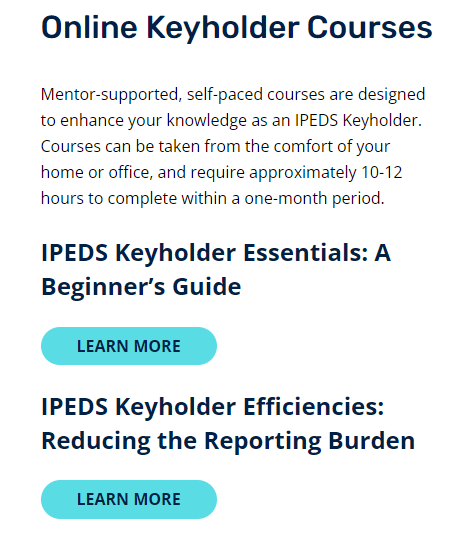
See the Resources section of this manual for more information about training opportunities.
M![]() any
keyholders work with others on campus to provide data for IPEDS
reporting. You may also work with staff at other sites and
locations. To make sure your institution reports accurate data on
time, you should:
any
keyholders work with others on campus to provide data for IPEDS
reporting. You may also work with staff at other sites and
locations. To make sure your institution reports accurate data on
time, you should:
Equip all data providers with the resources they need:
S
 urvey
materials for the appropriate survey component such as;
urvey
materials for the appropriate survey component such as;
Screens,
Instructions for reporting,
Frequently Asked Questions, or FAQs, and
Technical (import) specifications;
Instructions on how to access the IPEDS Glossary; and
Instructions on how to access the web tutorials and other training resources.
Communicate the importance of timely and accurate IPEDS reporting to all data providers. Remind them of the following at least annually:
Submitting accurate data on time is a federal requirement; and
Noncompliance may lead to Title IV program participation;
Limitations,
Monetary penalties, and
Ineligibility.
Develop an internal reporting calendar or Gantt chart that includes the following:
S
 urvey
components and survey items;
urvey
components and survey items;Action(s) to be taken such as;
Data collection/extraction,
Data review,
Error resolution,
Data submission, and
Survey component locking;
Individuals responsible;
Due dates; and
Special instructions.
If applicable, contact your state or system IPEDS coordinator early in the annual data collection planning cycle to confirm:
Contact person(s) and contact information;
Data collection and data submission process responsibilities; and
State or system reporting deadlines, which may differ from NCES IPEDS reporting deadlines.

 Edits
and errors
Edits
and errors
Y![]() ou
may receive error messages as you enter your data. Each survey
component contains interactive edits that will check for blank
fields, invalid data, or data that fall outside expected ranges.
Edits are in place to protect the integrity of the data and are only
triggered when there is something about the reported data that
requires additional attention.
ou
may receive error messages as you enter your data. Each survey
component contains interactive edits that will check for blank
fields, invalid data, or data that fall outside expected ranges.
Edits are in place to protect the integrity of the data and are only
triggered when there is something about the reported data that
requires additional attention.
There are three types of edits in the data collection. They are:
Confirmation edits: These are error messages received for minor data irregularities that require you to confirm the information provided is correct.
Explanation edits: Typically, error messages received for data anomalies that require an adequate and reasonable explanation from the institution.
Fatal edits: This type of error message is received when inaccurate, inconsistent, or out of range data is reported. Usually, you must revise the data or contact the IPEDS Help Desk to help resolve the edit.

P![]() rovide
adequate and reasonable information to resolve system edits that
require explanations. The IPEDS Help Desk will follow up with
institutions that provide inadequate explanations.
rovide
adequate and reasonable information to resolve system edits that
require explanations. The IPEDS Help Desk will follow up with
institutions that provide inadequate explanations.
Do not attempt to overcome edits by changing data that are correct. If the data you have reported are correct and you need to clear an edit, please contact the Help Desk and, if it is determined that they data are correct, they can provide an override. Remember, compliance for IPEDS reporting is based on timely and accurate data.
Fixing errors from the prior year
The IPEDS Prior Year Revision (PYR) system is available to allow institutions to correct errors in their prior year data submissions. All survey components are available for revision during their regular collection period, except that Fall survey components open a week later. Data providers login to PYR system using their current year User ID and password.
If, in the prior year, your institution failed to respond to one or more of the survey components, you may also supply your missing data using this system. The availability of this system DOES NOT INDICATE that institutions are no longer required to report data according to the current year IPEDS collection schedule. This is NOT an extension of your due date and the Office of Federal Student Aid will continue to take appropriate action against schools that do not meet their IPEDS reporting requirements.
Context boxes
Optional context boxes allow you to provide more information about the data you are reporting. For example, if your institution has a substantial number of part-time students, you may want to add the following in the Student Financial Aid (SFA) survey component’s context box for Part F Net Price Calculation for full-time, first-time degree-/certificate-seeking undergraduate students who paid the lower of in-state or in-district tuition rate and were awarded grant or scholarship aid from the federal government, state/local government, or the institution and/or Part G Net Price Calculation for full-time, first-time degree-/certificate-seeking undergraduate students who paid the lower of in-state or in-district tuition rate and were awarded any Title IV federal student aid:
“The average net price for the majority of our students may differ from the amounts listed because they enroll less-than-full time.”
Information entered in these context boxes may be made public on College Navigator, so make sure that the information you enter can be easily understood by students, parents, and the general public, and is free of grammatical or spelling errors.

S![]() ome
institutions enter information in the context boxes that does not
correspond with the data being reported on the screen or that is not
appropriate for public consumption. NCES reviews the information in
the context boxes and will not publish information that is not
applicable or appropriate for public consumption.
ome
institutions enter information in the context boxes that does not
correspond with the data being reported on the screen or that is not
appropriate for public consumption. NCES reviews the information in
the context boxes and will not publish information that is not
applicable or appropriate for public consumption.
Summary screens
Each survey component has one or more summary screens, which keyholders should review carefully. These screens contain reported values and calculated statistics that will appear on College Navigator, the College Affordability and Transparency Center, and the Data Feedback Reports. Verifying the data before they appear in these very public places may prevent data reporting errors that lead to consumer misinformation.
Each August, many keyholders are asked to verify their institution’s Report Mapping. An IPEDS Reporting Map describes how the data from the various campuses that are listed on the institution’s Program Participation Agreement (PPA) are accounted for in the institution’s IPEDS reporting.
If there are differences between how your institution and additional locations are listed in IPEDS and how they are listed in on your PPA, you will need to explain what that means for your IPEDS reporting. You will be presented with screens on which to do this.
N![]() ot
all PPAs are currently accurate. As a keyholder, you may need to
work with your Financial Aid office to reconcile the IPEDS Reporting
Map, and your institution may need to contact the office of Federal
Student Aid to get PPA inaccuracies corrected. Contact information
for each state is available at
ot
all PPAs are currently accurate. As a keyholder, you may need to
work with your Financial Aid office to reconcile the IPEDS Reporting
Map, and your institution may need to contact the office of Federal
Student Aid to get PPA inaccuracies corrected. Contact information
for each state is available at
The calendar system for your institution has major implications for how you will complete the IPEDS survey components. The chart below provides more detailed information about these implications.
Understanding How IPEDS Reporting is Affected by Calendar System |
|||
|
Academic Reporter Calendar Systems |
Program Reporter Calendar Systems |
Hybrid Calendar Systems |
IC-Header (IC-H) Institution specifies predominant calendar system. For institutions NOT new to IPEDS, this is preloaded. Changes can only be made by Help Desk staff. |
Semester Quarter Trimester 4-1-4 |
Continuous enrollment Differs by program |
Other academic |
Institutional Characteristics (IC) Cost of attendance for FTFT degree/certificate-seeking undergraduate students |
Cost of attendance for an academic year |
Entire cost of the LARGEST program Breakdown of living expense costs per month, for students in the largest program |
Cost of attendance for an academic year |
Institutional Characteristics (IC) Average tuition & fees for all undergraduates |
Average tuition & fees for an academic year for full-time and per credit for part-time |
For 2nd – 6th largest programs, total tuition & fees for each program |
Average tuition & fees for an academic year for full-time and per credit for part-time |
Student Financial Aid (SFA) – Section 1 Reporting period |
Standard academic year |
Defined by the institution; must fall within the period of July 1 through June 30 |
Standard academic year |
Student Financial Aid (SFA) – Section 1 Student cohort |
Students enrolled on October 15, or the institution’s official fall reporting date |
Students enrolled at any time within the institution’s academic year |
Students enrolled at any time within the period of August 1 through October 31 |
Fall Enrollment (EF) Students enrolled |
Students enrolled on October 15, or the institution’s official fall reporting date |
Students enrolled at any time within the period of August 1 through October 31 |
|
Graduation Rates (GR & GR200) Student cohorts |
Fall cohort: Entering FTFT degree/certificate-seeking undergraduate students who enrolled on October 15, or the institution’s official fall reporting date |
Full-year cohort: Entering FTFT degree/certificate-seeking undergraduate students who enrolled at any time within the period of September 1 through August 31 |
|
Outcome Measures (OM) Student cohort |
Full-year cohort: Entering degree/certificate-seeking undergraduate students who enrolled any time within the period of July 1 through June 30. |
||
Using the IPEDS Data Collection System
 You
will use the IPEDS web-based Data Collection System (DCS) to submit
your institution’s data. Here are some tips for using it. The
Data Collection System is password protected. You will receive a
UserID and password each August when registration opens. You can
create up to 16 additional UserIDs and passwords for others on your
campus (using the Tools menu).
You
will use the IPEDS web-based Data Collection System (DCS) to submit
your institution’s data. Here are some tips for using it. The
Data Collection System is password protected. You will receive a
UserID and password each August when registration opens. You can
create up to 16 additional UserIDs and passwords for others on your
campus (using the Tools menu).

Selecting Answer the Current Survey on the Report Your Data webpage will take you to the DCS login screen. Enter your current User ID and Password, then select LOGIN. You can also reset your password from this screen if needed.


Data Collection System Features:
|
S
T
Built-in interactive edits flag potential data problems, discrepancies, and errors.
The system pulls data forward from one section to another where totals need to match.
Prior year reported values are included, in red, on many screens for comparison and editing.
|


Instructions
T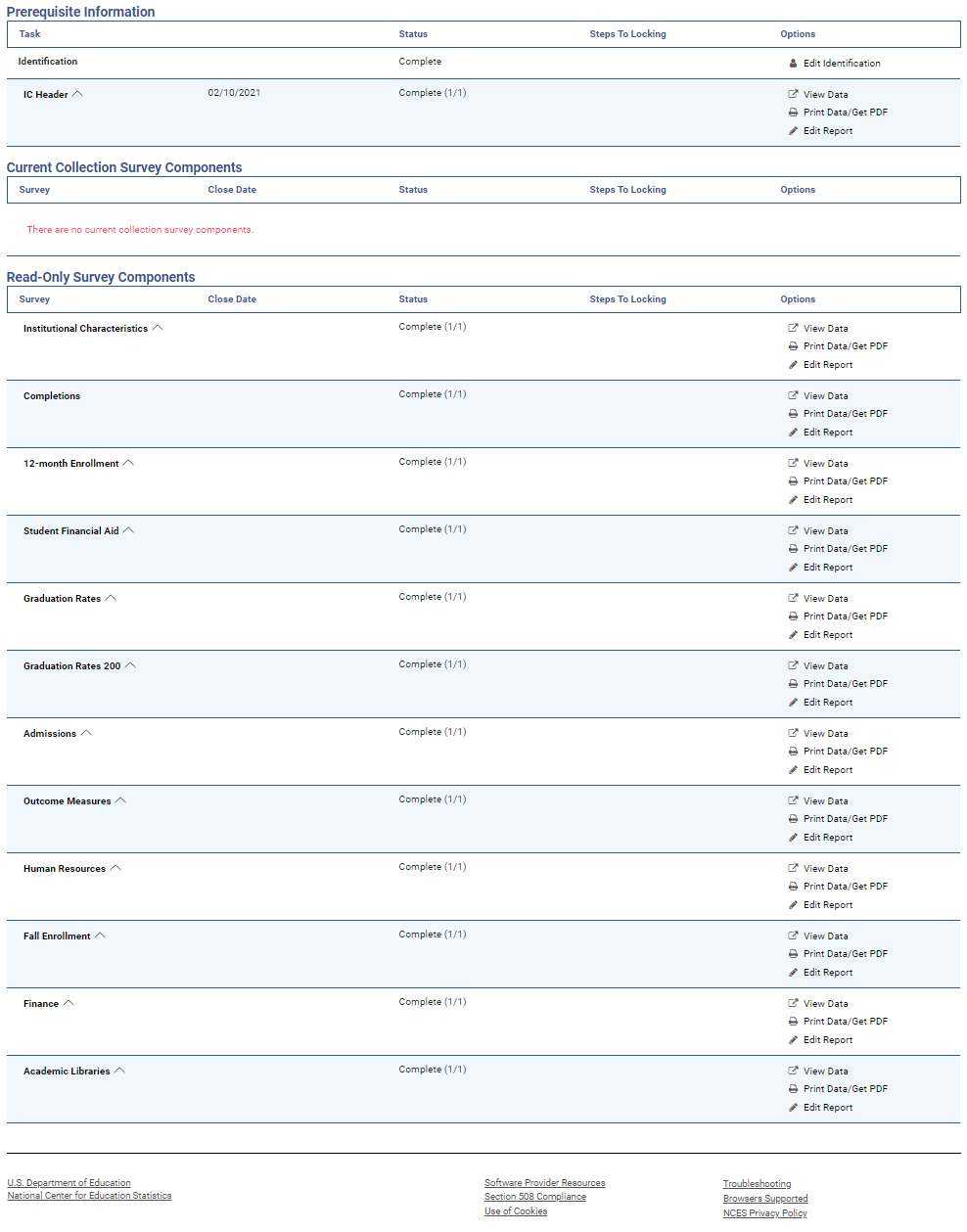 his
is the screen you see once you log into the DCS.
his
is the screen you see once you log into the DCS.
I![]() nstructions
are included on most screens from a link in the upper right-hand
corner.
nstructions
are included on most screens from a link in the upper right-hand
corner.
Across the top is a menu bar. Clicking Surveys will bring you back to this screen.
On the Surveys screen, each survey is listed, along with the date it closes, status, steps required before it is ready to be locked and options available. Click on the links to perform the desired action.
-
Survey Status Definitions
Not Applicable
Institution is not required to complete the survey or content is not relevant to the institution.
NO DATA
Screening questions have not been answered.
Responses to screening questions are required to generate survey screens.
No Data
Screening questions have been answered but no data have been provided.
Has Data
Some data have been entered, but survey is not complete.
Perform edits must be run.
Edited
Edits have been run.
Go to Edit Report to resolve any errors.
Clean
All survey questions have been answered and all edit errors and issues have been resolved. The survey component can be locked.
Locked
Data have been successfully submitted and locked by the institution.
Final lock must still be applied (by system level or state level coordinator), if applicable. If there are no “locking” coordinators, the survey
status will go straight to Complete.
Complete
There are two options for entering data into the DCS: manual key entry and data upload. You can use different methods for different survey components.
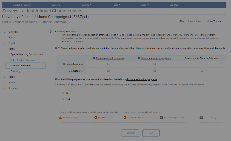 When
keying data into the system, each screen is saved separately, using
the buttons at the bottom of the screen.
When
keying data into the system, each screen is saved separately, using
the buttons at the bottom of the screen.


 Underlined
terms that appear on the survey screens are linked to the glossary;
mouse over the link for the definition. Instructions for each
screen are available by clicking the Instructions
link in the upper right-hand corner of the screen. Also, at the top
of some screens, you can find links to FAQs and/or online tutorials
applicable to the survey section.
Underlined
terms that appear on the survey screens are linked to the glossary;
mouse over the link for the definition. Instructions for each
screen are available by clicking the Instructions
link in the upper right-hand corner of the screen. Also, at the top
of some screens, you can find links to FAQs and/or online tutorials
applicable to the survey section.
 T
T he
File Upload option is found under the Tools
menu. You’ll need to have a file formatted to specifications
in order to perform the upload. Upload specifications are part of
the survey materials.
he
File Upload option is found under the Tools
menu. You’ll need to have a file formatted to specifications
in order to perform the upload. Upload specifications are part of
the survey materials.
 There
are 2 upload formats:
There
are 2 upload formats:
Fixed width file and
Key value file.
Uploading files minimizes data entry errors and reduces data entry time.
No matter how you enter your data, you will need to run the interactive edits to see if there are any edit issues or potential errors. Some edits are run automatically when you save data on a screen. Other edits are run when you click the Perform Edits link on the Surveys page. Error icons will usually appear on a screen next to a data field; the icons identify the kind of error, and the severity of the problem. If you click on an icon, you will get a description of the problem.
The error icon descriptions are displayed on each screen:

Error Types |
|
Invalid data type
|
The type of data entered in the field is incorrect. For example, an alpha character has been entered into a numeric field. |
Confirmation
|
Certain data must be verified to check that the data entered is what is intended. No explanations are necessary. |
Explanation
|
The data have been flagged because an unexpected value was entered. Check for keying errors. Check to make sure the data are correct. If the data are correct, enter an explanation. The icon turns grey when an explanation has been entered. Explanations may be edited by clicking on the icon. |
Fatal
|
The data have been flagged for a serious error. This could be due to missing data; inconsistency between survey parts or survey components; reporting rule violations; or discrepancies between data values and institutional demographics. Please review the data for accuracy and correct any incorrect data. Check for keying errors. Do not change correct data to try to erase the error. If the data are correct or you do not understand the error, contact the IPEDS Help Desk. Help Desk staff will provide an override if needed. |
Override by administrator
|
A fatal error has been overridden by an IPEDS Help Desk administrator because the data submitted are correct based on reporting requirements and the explanation provided by the keyholder. |
Resolving Errors
All errors must be resolved before the component can be locked. This means that all confirmation edits need to be confirmed, explanations must be entered for all explanation errors, and all fatal errors must be fixed or overridden.
Once you have clicked Perform Edits on the Surveys screen, you will be able to access the Edit Report. This is a concise listing of all edit errors, confirmations, explanations, and data issues for the survey component. This report also lists the status of each error.

On this screen, you can see a description of each edit that has flagged out for your review. The Resolved column shows if action is required to resolve the error. All edits must show Yes in the Resolved column before you can lock the survey component. Click on the Explanation link in the Severity column to explain the data. Click on the links in the Options column to return to the survey screens.
Follow the Steps to Lock EACH survey component:
Enter data
Perform edits
Resolve errors (enter explanations in edit report, or correct data when appropriate)
Perform edits again
Repeat steps 3 and 4 as needed, until survey status is Clean
Lock survey
Explanation Edits and Context Boxes
Explanation edits and context boxes are similar, but they ARE NOT THE SAME. They are similar because explanations both allow data providers to submit explanations and additional information about data items. The difference is explanation edits are for internal use by IPEDS DCS staff only whereas context boxes are published on College Navigator with the institution’s data.
Help Desk staff review ALL edit explanations and context box text. Context box text that provides additional information to help students and parents make informed decisions about postsecondary education institutions are published on College Navigator. Help Desk staff will not post advertisements, conflicting information, or text that does not match the data on College Navigator.
Explanation edits request reasons for conflicting data, unexpected data changes, and/or other data anomalies. Explanations must be entered to resolve these edits. Please provide clear and comprehensive explanations for why the data are compliant and correct as entered. This will minimize questions and follow-up during the NCES data review process. Help Desk staff will contact the data provider if we cannot understand your explanation, or if the explanation does not match the data or line up with the instructions. The following is an example of an explanation edit.

Other explanations for this error are:
Some students who enrolled in the general AS or AA program changed their majors to Biological and Biomedical Science programs.
Since our institution has a waiting list for this program, some students who enrolled in the general AS or AA program later changed their majors to the Biological and Biomedical Science programs when space became available.
Common Error Descriptions and Explanation Edit Examples |
For large variances from the prior year:
For not having additional completers between 151-200%:
|
Context boxes are optional. They give you the opportunity to provide further information or “context” that may help reviewers and data users understand and interpret the data. Please pay special attention to make sure text is suitable for publication on this federal website (when applicable), which is used by national and international consumers. Review and edit your text to make sure it does not contain grammar or punctuation errors. The text will appear on the same screen as the data, so ONLY include context notes that are relevant to the displayed data.

Context box text examples |
Context box text should be clear, concise, explanatory and factual.
Examples of good context notes:
|
Context box text should NOT be a marketing opportunity or an edit explanation.
Examples of what to avoid:
This is advertising, and it may or may not be factual.
This is an explanation edit. It explains why the average amount is outside the expected range. It is for internal IPEDS staff use only and should not be posted on College Navigator. |
 The
survey status must be Clean
before a survey can be locked. The survey screen lists all unlocked
survey components and the Steps to Locking. Remember, all survey
component questions must be answered, and all confirmation,
explanation, and fatal edits must show Yes in the Resolved column
before a survey component is considered complete, clean, and ready
to be locked.
The
survey status must be Clean
before a survey can be locked. The survey screen lists all unlocked
survey components and the Steps to Locking. Remember, all survey
component questions must be answered, and all confirmation,
explanation, and fatal edits must show Yes in the Resolved column
before a survey component is considered complete, clean, and ready
to be locked.
To lock a survey, follow the Steps to Locking then click on the Lock link on the Surveys screen. Once a survey component is locked, the data become “view only” and a confirmation email is sent. You may want to print and save the confirmation for your records. If you discover you need to make a correction to the data after the survey component is locked, contact the Help Desk and ask them to unlock the survey.

 Once
the survey is locked, you can print out the data for your records
and/or save is as a PDF using the Print Data/Get PDF link in the
Options column.
Once
the survey is locked, you can print out the data for your records
and/or save is as a PDF using the Print Data/Get PDF link in the
Options column.
Help Menu
 There
are many resources available under the Help menu in the DCS
such as survey collection system
changes and tutorials; handbooks and flyers; and FAQs. Also, please
do not hesitate to contact the IPEDS Help Desk if you have any
questions, at 1-877-225-2568, or ipedshelp@rti.org.
There
are many resources available under the Help menu in the DCS
such as survey collection system
changes and tutorials; handbooks and flyers; and FAQs. Also, please
do not hesitate to contact the IPEDS Help Desk if you have any
questions, at 1-877-225-2568, or ipedshelp@rti.org.

Reminder emails and phone calls
NCES sends out many follow-up emails to keyholders, to remind them of the collection due dates. Here is the communication schedule for each collection:
Email to keyholder that the collection has opened;
Email to keyholder, if no data have been entered by 4 weeks before the collection closes;
Email to new keyholder, if all surveys are not locked by 4 weeks before the collection closes;
Phone call to keyholder or CEO, if no data have been entered by 2 weeks before the collection closes;
Phone call to new keyholder or CEO, if all surveys are not locked by 2 weeks before collection closes;
Email to keyholder if all surveys are not locked by 2 weeks before the collection closes; and
Email to keyholder if all surveys are not locked by 1 week before the collection closes.
An automatic email is sent to keyholders upon registration and when contact information is updated. Automatic emails are also sent to keyholders (and coordinators, when applicable) when each survey component is locked.
IES NEWSFLASH SUBSCRIPTION SERVICE
Newsflash is a voluntary email alert system. It provides breaking news about IES, its Centers, and programs including IPEDS. All you need is an email address to sign-up. Go to https://ies.ed.gov/newsflash/, enter your email address, and click subscribe. Next, select the topics and programs for your email alerts. Do not forget to select IPEDS.
If all survey components for a collection are locked by 3 weeks before the collection closes, a thank-you email will be sent to your institution’s CEO. This email will mention the keyholder by name, as the person primarily responsible for this accomplishment.
This Week in IPEDS
These emails are sent out whenever there is important information or announcements that need to be communicated to keyholders. This Week in IPEDS can also be found on the IPEDS website by selecting About IPEDS or Collaborate with NCES on the IPEDS homepage at https://nces.ed.gov/ipeds/.
Training opportunities Emails
Special emails are sent out periodically to alert keyholders to IPEDS training opportunities. See the Resources chapter of this handbook for more information.
some notes concerning Communications from the Help Desk
If you receive a communication from Help Desk staff or NCES requesting a response, please do not ignore it. Many times, we are trying to prevent you from having compliance issues or unfavorable (and incorrect) data published on College Navigator, the FAFSA website, the College Affordability and Transparency Center, and in the Data Feedback Reports.
NCES will contact your CEO if you have not responded by a particular date as a safeguard, since frequently a failure to respond indicates that the keyholder has left the institution and has not been replaced. These calls start approximately 2 weeks prior to the end of collection, which would give a replacement keyholder enough time to gather the data and complete the survey components.
Towards the end of collection or during the NCES quality control review process, we may contact some keyholders regarding data quality issues. We will typically request clarification of an explanation or need to resolve conflicting data. Frequently, these issues can be resolved in just a minute or two, though more complex issues may require more time. Staff will continue to reach out to data providers until the matter is resolved. If the matter is not resolved before the data is published Help Desk staff in consultation with NCES staff will decide on whether the severity of the issues prohibits some or all of the institution’s data from being published.
Tips from Veteran Keyholders and the IPEDS Help Desk
Start early to allow sufficient time to address and issues or questions.
Develop and communicate a strategy and timeline with all of the departments that will be providing data and follow-up periodically to make sure that all data will be available on that timeline.
Make sure that other offices understand the data collection system interface, as well as data requirements and definitions.
Read all IPEDS training materials, watch the IPEDS tutorials, and share them with others providing data.
Create your own set of audits for each survey component to allow a quick check before locking the survey component.
Read the instructions and FAQs for each survey component. Do not assume you know what is required if you have not fully read this information.
The Overview screen of each survey component shows any major changes for the year, and the summary screen at the end of each survey component gives you a chance to look at much of the data one last time to make sure it is correct – use both to your advantage.
Look at the reporting dates for the various survey components before the reporting year starts. Some survey components collect data on different years depending on the section of the survey. For example, Fall Enrollment (EF) collects data on the most recent fall cohort and data on the student cohort you reported in the prior year.
COLLABORATING WITH others
When communicating with other offices, highlight any changes made to the survey component(s) since the last submission.
As needed, add additional users/passwords so other offices can assist you with data entry. The keyholder will still need to lock the survey component.
Provide other offices a deadline that is at least one week prior to the IPEDS deadline since you will need to review the data, run error reports, and lock the survey.
Create a positive work environment for those who are part of your IPEDS team. Thank team members for gathering data. Be sure to be available to answer questions and provide assistance, and respect the timing of other projects they may be working on and schedule things accordingly.
verifying data
Remember, these data are published in a lot of public places, including federal website. Make sure it is an accurate representation of your institution.
Compare current year data with as many prior years as possible. This provides a trend and enables you to look at the items in summary form to identify and correct inconsistencies.
Compare data compiled in IPEDS to other reports (financial statements, surveys, state reports, etc.) and double check the definitions.
Compile data from peer institutions and see how your institution’s data compare to similar institution’s data.
Although adjustments and corrections can be made to data in the Prior Year Revision (PYR) system, the data may not be updated on some websites. While some adjustments may be required based on audits, accreditation visits, or program reviews after the PYR system closes, they are for internal use only. Please take your time and make the effort to report data that are clean, complete, and accurate.
keeping records
Document the datasets, queries, and files used for IPEDS reporting. Includes notes on questions or issues raised, how you resolved them, and the rationale for your decision(s).
Keep notes on where get data from and on information that is duplicated for state/federal reporting.
Keep both an electronic filing system and hard copies of the IPEDS survey reports in binders. Include hard copies of the completed survey components, procedures manuals, worksheets, programming scripts, and communication pertaining to the survey component.
Share the final submission with the office responsible for providing the data. This provides quick and easy access to institutional data; fosters effective communication and interoffice support; and will help your IPEDS reporting team submit consistent and comparable data each year.
getting advice
To design or improve your institution's IPEDS reporting process, consult with keyholders from similar institutions or others with whom you have a good working relationship.
getting help
If you need any help, have questions, or any doubts about the accuracy of what you are reporting, call or email the IPEDS Help Desk – preferably early in the collection cycle.
IPEDS Resources – Where to Get Help
The IPEDS website is available at http://nces.ed.gov/ipeds/. Once there, you will find a lot of good information.
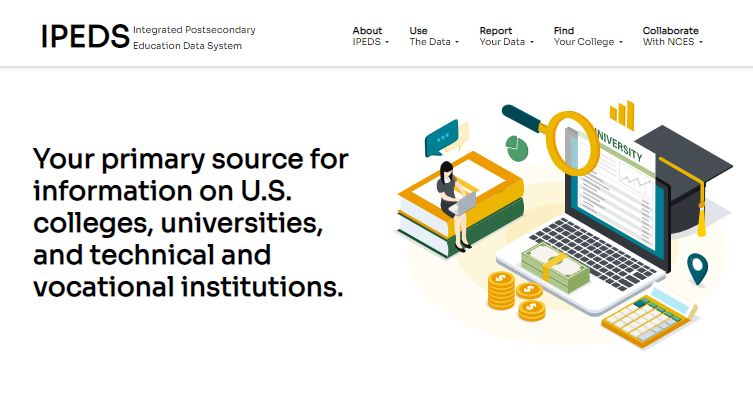
About IPEDS: This webpage provides an overview of each survey component and the data collected. It also contains links to other resources, including Survey Director contact information.
Use the Data: This webpage provides data users with access to IPEDS data through variety of data tools and allows to download the data to conduct research and analyses.
Report Your Data: This webpage has many resources for data reporters including access to the data collection system; survey materials and collection schedule; and reporting guides and tools.
Find Your College: This webpage allows students and parents search for a college, explore resources to plan, prepare, and graduate from college using College Navigator, the College Scorecard, and the College Affordability and Transparency Center.
Collaborate with NCES: Join discussions and learn more about IPEDS training and other activities such as data releases, peer group discussions, and research and development efforts by following IPEDS on Twitter @IPEDS_NCES and by joining the IPEDS Knowledge Exchange (formerly Listserv).
IPEDS training, in the form of web tutorials and face-to-face workshops, is available to IPEDS keyholders, other data providers, and data users.
Online tutorials covering IPEDS data submission and data use are available from the IPEDS website by selecting Training & Outreach from the Collaborate with NCES webpage. These free tutorials are available 24 hours a day so you can use them any time from any place to fit your schedule. There are four types of video tutorials available:
The New Keyholder Online Tutorials are designed specifically for new keyholders to provide an overview of keyholder responsibilities and how the IPEDS data submission process works.
The IPEDS Annual Update Tutorial provides an overview of the data collection schedule, as well as current and future changes to the data collected and the data collection system.
The survey component web tutorials assist with understanding the key concepts for and common pitfalls to submitting accurate data on the different survey forms. In addition to accessing these tutorials from the Training & Outreach menu on the IPEDS website mentioned previously, you can also access them from the IPEDS DCS Help menu on associated screens. The survey component web tutorials are posted by the opening of each data collection period. You will receive a training alert via email as they become available.
Finally IPEDS Data Tools and related tutorials explain how to view, analyze, extract, and download IPEDS data using IPEDS tools (e.g., College Navigator, Data Center, Trend Generator, and Data Explorer), as well as other IPEDS related educational topics, such as the Net Price Calculator.
IPEDS workshops are held in various locations across the country and there is no charge to attend. Attendance preference is given to keyholders. Two workshops of interest to keyholders and others who report IPEDS data are the New Keyholder workshop and the Best Practices for Reporting and Using IPEDS Data workshop:
The New Keyholder workshop is designed as entry-level training that provides participants with a thorough introduction to the IPEDS data collection cycle and reporting requirements. Created specifically for new IPEDS keyholders, this workshop outlines the roles and responsibilities of a keyholder and the resources available to assist in the IPEDS planning and reporting processes. The workshop also provides participants an opportunity to create an IPEDS planning calendar for the next data collection cycle. Because this workshop is designed for new keyholders, it also serves as a valuable professional networking opportunity for institutional researchers in their new roles.
The Best Practices for Reporting and Using IPEDS Data to Improve Office Efficiencies workshop is intermediate-level keyholder training designed for individuals who lead the IPEDS data submission cycle on their campus and have done so for at least one full reporting cycle. Using IPEDS as a focus, participants will: (a) learn IR best practices and technical efficiencies in data management using Excel (e.g., pivot tables, merging data, custom formulas, and filters); (b) examine multiple options for IPEDS submission (manual entry, .csv file upload, and XML); and (c) learn how to use benchmarking data to address key institutional questions and needs.
Other workshops are also available that focus on data use, benchmarking, and IPEDS Finance data. Training emails sent to keyholders will alert you to these workshops. You can learn more about these opportunities by selecting Training & Outreach from the Collaborate with NCES webpage on the IPEDS homepage.
Two online IPEDS keyholder courses provide self-paced, on-demand training for data providers. Courses are mentor supported. Courses include papers, videos, and exercises, and take around 10-12 hours to complete.
The first course, IPEDS Keyholder Essentials: A Beginner’s Guide, is designed for keyholders with 0-9 months of experience. It provides an overview of IPEDS and focuses on:
Accessing IPEDS data;
Keyholder responsibilities;
Important IPEDS concepts and definitions;
Working with cohort data;
Managing a data collection cycle; and
Ensuring quality data.
The second course, IPEDS Keyholder Efficiencies: Reducing the Reporting Burden, is designed for keyholders with 10-24 months of experience. It takes an in-depth and application-based approach to working with IPEDS by discussing:
IPEDS data nuances;
How IPEDS compares and connects with other institutional and national datasets;
How to improve office project management and data submission efficiencies; and
Using IPEDS data to increase institutional effectiveness.
Data Collection System Tutorial

A tutorial that explains how to use the IPEDS Data Collection System (DCS) can be found under the Help menu. This tutorial provides training on navigating the DCS; submitting data; and using system tools and reports.
The IPEDS website also has reporting tools with links to tutorials, taxonomies, and tips sheets. In addition to checking your institution’s survey component status, you can access the following Information Centers:
• Academic Libraries,
• Human Resources,
• Net Price Calculator, and
• Race/Ethnicity.
 Each
center contains information and resources on reporting compliant
data to IPEDS. You can access IPEDS Reporting Tools by selecting
Report Your Data on the IPEDS homepage.
Each
center contains information and resources on reporting compliant
data to IPEDS. You can access IPEDS Reporting Tools by selecting
Report Your Data on the IPEDS homepage.
O nce
IPEDS data have been entered, edited, cleaned, and locked, they pass
through additional review by the IPEDS Help Desk and NCES. The Help
Desk runs additional checks on the data before they are migrated to
the dissemination server. At this time, the edit explanations and
context notes are reviewed, and the keyholder may be contacted if
questions about the data submission arise. The Help Desk begins
migrating the data while the data collection is still in progress.
nce
IPEDS data have been entered, edited, cleaned, and locked, they pass
through additional review by the IPEDS Help Desk and NCES. The Help
Desk runs additional checks on the data before they are migrated to
the dissemination server. At this time, the edit explanations and
context notes are reviewed, and the keyholder may be contacted if
questions about the data submission arise. The Help Desk begins
migrating the data while the data collection is still in progress.
Once the data are migrated, they are available at the collection level in the IPEDS Data Center. Keyholders (and anyone who has a UserID and password for the Data Collection System) can access the collection level data in the Data Center as soon as their own institution’s data are migrated; to do this, use the Tools menu in the Data Collection System. Migration continues after the data collection closes.
Once the data are migrated, NCES does additional Quality Control checks; keyholders may be contacted if questions arise.
Soon after the data collection closes, College Navigator is updated.
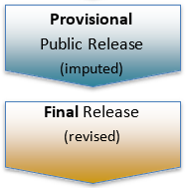 Web
Tables are released and Provisional (imputed) data are made publicly
available through the data tools approximately 6 months after the
close of the collection. Final data are made public through the data
tools approximately one year
later.
Web
Tables are released and Provisional (imputed) data are made publicly
available through the data tools approximately 6 months after the
close of the collection. Final data are made public through the data
tools approximately one year
later.

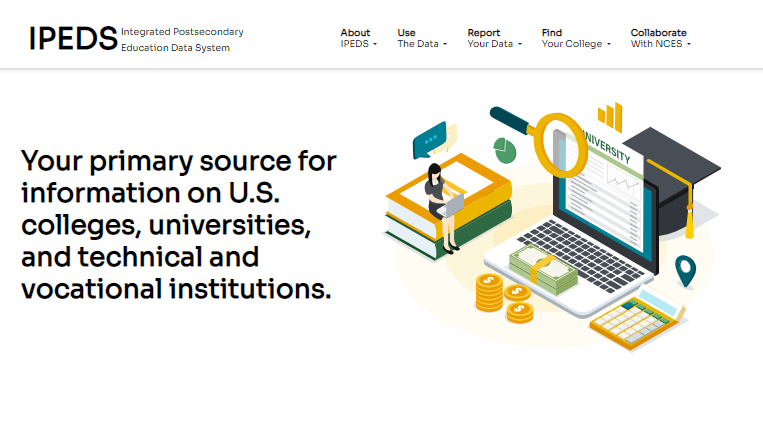

 Use
the Data is the place to go to get IPEDS data. The IPEDS Tools Help
Desk phone number is on every screen in the data tools.
Use
the Data is the place to go to get IPEDS data. The IPEDS Tools Help
Desk phone number is on every screen in the data tools.


Select NCES Newsflash →National Center for Education Statistics (NCES) →Integrated Postsecondary Data System (IPEDS) to receive automated email messages about new IPEDS content of the Institute for Education Science (IES) website.
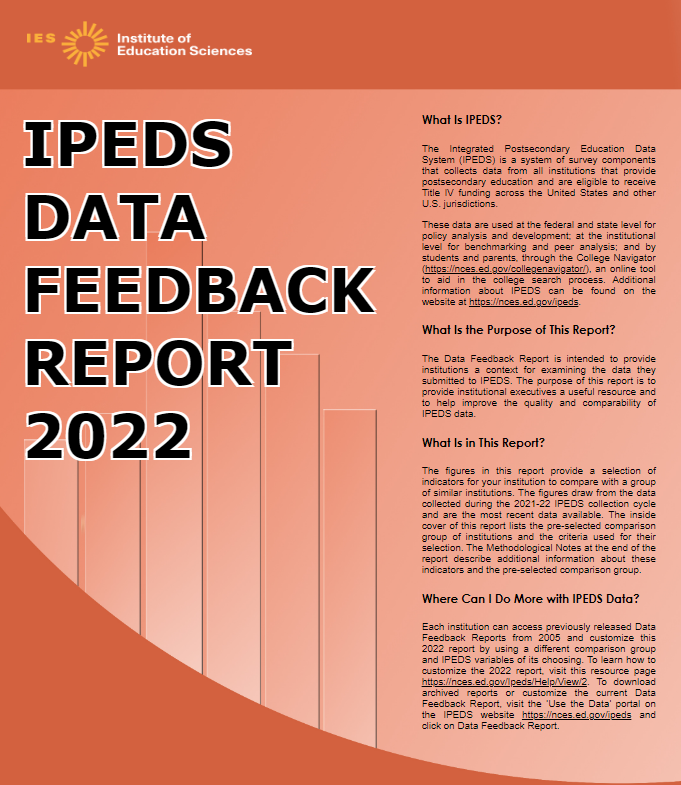 The
Data Feedback Report
(DFR) provides each institution a context for examining the data
they submitted to IPEDS. This annual report that is used by
institutional executives and administrators for peer analyses and
comparisons.
The
Data Feedback Report
(DFR) provides each institution a context for examining the data
they submitted to IPEDS. This annual report that is used by
institutional executives and administrators for peer analyses and
comparisons.
The report presents selected indicators and data elements for your institution and a comparison group of institutions. If the keyholder did not specify a comparison group to use, NCES uses an algorithm based on control type; Carnegie Classification or largest program of study; and student enrollment to select one for this report.
The figures are based on data collected during the most recently completed IPEDS collection cycle. A description of each indicator and methodology notes is included in the report, along with a list of the institutions used in the comparison group, and the criteria used for their selection.
The report is emailed to Chief Executive Officers and IPEDS keyholders and coordinators each winter. PDF and HTML versions of the reports are available to institutions and the public from the IPEDS Data Center.
Select the Data Feedback Report tool on the IPEDS Use the Data webpage to view and print DFRs; create Custom DFRs; and create statistical reports on selected variables. You can also create and download a Custom DFR spanning several years using different figures and/or comparison groups.
A s
a keyholder, it is your responsibility to verify the accuracy of
your institution's data. Remember, IPEDS data is published on the
College Affordability and
Transparency Center website
at http://collegecost.ed.gov/,
which includes the
College Scorecard,
College Navigator,
and the College
Affordability and Transparency List.
It is published in NCES Web
Tables,
Indicators, and in DFRs
when your institution is
selected as a peer or comparison institution by others. It is also
used by education administrators, policy makers, researchers, and
others who use the IPEDS
Data Center.
Therefore, it is a good practice to check your institution's data in
all locations where it is published as soon as possible after NCES
announces data releases that use IPEDS data.
s
a keyholder, it is your responsibility to verify the accuracy of
your institution's data. Remember, IPEDS data is published on the
College Affordability and
Transparency Center website
at http://collegecost.ed.gov/,
which includes the
College Scorecard,
College Navigator,
and the College
Affordability and Transparency List.
It is published in NCES Web
Tables,
Indicators, and in DFRs
when your institution is
selected as a peer or comparison institution by others. It is also
used by education administrators, policy makers, researchers, and
others who use the IPEDS
Data Center.
Therefore, it is a good practice to check your institution's data in
all locations where it is published as soon as possible after NCES
announces data releases that use IPEDS data.
AIR – Association for Institutional Research, develops and conducts IPEDS training
ADM – Admissions survey component
AL – Academic Libraries survey component
C – Completions survey component
CIP – Classification of Instructional Programs
DCS – Data Collection System
DFR – Data Feedback Report
E12 – 12-month Enrollment survey component
EF – Fall Enrollment survey component
F – Finance survey component
FAFSA – Free Application for Federal Student Aid
FSA – Office of Federal Student Aid
FTE – Full-time equivalent
GR – Graduation Rates survey component
GR200 – Graduation Rates 200% survey component
HEA – Higher Education Act
HR – Human Resources survey component
IC – Institutional Characteristics survey component
IES – Institute of Education Sciences
NCES – National Center for Education Statistics
NPEC – National Postsecondary Education Cooperative
OM – Outcome Measures survey component
OPEID – Office of Postsecondary Education Identification number (for Title IV)
PPA – Program Participation Agreement (for Title IV)
RTI – RTI International, operates IPEDS Help Desk
SFA – Student Financial Aid survey component
SOC – Standard Occupational Classification system (used in IPEDS HR reporting)
SRK – Student Right-to-Know
TRP – Technical Review Panel
The IPEDS survey components, conducted by the National Center for Education Statistics (NCES), play a key role in responding to the Center’s Congressional mandate under the Education Sciences Reform Act of 2002. The mandate states, “The duties of the Center are to collect, analyze, and disseminate statistical data related to education in the United States and in other nations, including —
collecting, acquiring, compiling (where appropriate, on a state-by-state basis), and disseminating full and complete statistics on the condition and progress of education, at the pre-school, elementary, secondary, and postsecondary levels in the United States, ...;
conducting and publishing reports and analyses of the meaning and significance of such statistics;
collecting, analyzing, cross-tabulating, and reporting, to the extent feasible, so as to provide information by gender, race, ethnicity, ... and other population characteristics...; and
assisting public and private educational agencies, organizations, and institutions in improving and automating statistical and data collection activities..."
Mandatory Reporting for Institutions with Program Participation Agreements
The completion of all IPEDS survey components, in a timely and accurate manner, is mandatory for all institutions that participate in or are applicants for participation in any Federal financial assistance program authorized by Title IV of the Higher Education Act (HEA) of 1965, as amended. The completion of the survey components is mandated by 20 USC 1094, Section 487(a)(17) and 34 CFR 668.14(b)(19). Specifically, under the current requirement, an institution agrees, “…It will complete, in a timely manner and to the satisfaction of the Secretary, surveys conducted as a part of the Integrated Postsecondary Education Data System (IPEDS) or any other Federal collection effort, as designated by the Secretary, regarding data on postsecondary institutions….
The Department of Education (ED) relies on postsecondary institutions to accurately report data to IPEDS, and nearly all institutions do. Institutions themselves sometimes identify misreporting issues and work with ED to correct those problems without the need for further action by the Department. The Department is concerned about any instances of intentional or significant misreporting. Under these circumstances, the Office of Federal Student Aid may take administrative action to appropriately address the issue.
Title IV, HEA program regulations 34 CFR 668.84, 668.85, and 668.86 provide that the Department may initiate a fine action or other administrative action, such as a limitation, suspension or termination of eligibility to participate in the Title IV, HEA programs, against institutions that do not comply with the requirement to complete and submit the survey components. The regulations permit a fine for each violation of any provision of Title IV, or any regulation or agreement implementing that Title. These fines are increased on an annual basis based on an inflation index. More information can be found in the Federal Register, ‘Adjustment of Civil Monetary Penalties for Inflation (under 20 U.S.C. 1094(c)(3)(B)’. In determining the amount of a fine, the Secretary considers both the gravity of the offense and the size of the institution (34 CFR 668.92(a)).
Each year, the Office of Federal Student Aid issues fine notices to institutions for not completing their IPEDS survey components in a complete and accurate manner within the required timeframes. Other institutions are sent warning letters. According to the Office of Federal Student Aid, an institution's failure to accurately complete and submit these survey components is a serious violation of its obligations under the Higher Education Act, and appropriate action will be taken.
Vocational Education Data
Education Sciences Reform Act (ESRA) of 2002 (P.L. 107-279) which directs NCES to collect, report, analyze, and disseminate statistical data related to the condition and progress of postsecondary education, including access to and opportunity for postsecondary education (including data on financial aid to postsecondary students), the financing and management of education (including data on revenues), student participation in and completion of postsecondary vocational and technical education programs by specific program area, and the existence and use of school libraries. The data related to vocational programs and program completions are collected from postsecondary institutions known to provide occupationally specific vocational education.
Some IPEDS data collected satisfy certain requirements pursuant to Section 421(a)(1) of the Carl D. Perkins Vocational Education Act. Specifically, data related to vocational programs and program completions are collected from postsecondary institutions known to provide occupationally specific vocational education.
Data on Race/Ethnicity and Gender of Students
The collection and reporting of race/ethnicity and gender data on students and completers are mandatory for all institutions which receive, are applicants for, or expect to be applicants for Federal financial assistance as defined in the Department of Education (ED) regulations implementing Title VI of the Civil Rights Act of 1964 (34 CFR 100), or defined in any ED regulation implementing Title IX of the Education Amendments of 1972 (34 CFR 106). The collection of race/ethnicity and gender data in vocational programs is mandated by Section 421(a)(1) of the Carl D. Perkins Vocational Education Act.
DATA ON RACE/ETHNICITY AND GENDER OF STAFF
The collection and reporting of race/ethnicity and gender data on the Human Resources (HR) survey component are mandatory for all institutions which receive, are applicants for, or expect to be applicants for Federal financial assistance as defined in the Department of Education (ED) regulations implementing Title VI of the Civil Rights Act of 1964 (34 CFR 100). The collection of data is also mandated by P.L. 88-352, Title VII of the Civil Rights Act of 1964, as amended by the Equal Employment Opportunity Act of 1972 (29 CFR 1602, subparts O, P, and Q). Institutions with 15 or more full-time employees are required to respond to the IPEDS Human Resources (HR) survey component under this mandate.
Student Right-to-Know and campus security act of 1990 (SRK)
Sections 668.41, 668.45, and 668.48 of the Student Assistance General Provision (34 CFR 668) were amended to implement the SRK, as amended by the Higher Education Amendments of 1991 and further by the Higher Education Technical Amendments of 1993 and 1999. The final regulations require an institution that participates in any student financial assistance program under Title IV of the Higher Education Act of 1965, as amended, to disclose information about graduation or completion rates to current and prospective students. The final regulations also require such institutions that also award athletically related student aid to provide certain types of data regarding the institution's student population, and the graduation or completion rates of categories of student-athletes, to potential athletes, their parents, coaches, and counselors.
Section 101 of the Higher Education amendments of 1965 (P.L. 105-244) requires that NCES collect the following information about undergraduate students from institutions of higher education:
Tuition and fees,
Cost of attendance,
The average amount of financial assistance received by type of aid, and
The number of students receiving each type.
Section 132 of the Higher Education Opportunity Act (HEOA) of 2008 (P.L. 110-315) requires that NCES make the following consumer information about postsecondary institutions available on the college search web site: the institution’s mission statement; a link to the institution’s website that provides, in an easily accessible manner, information on student activities, services for individuals with disabilities, career and placement services, and policies on transfer of credit; admissions rates and test scores; enrollment by race and ethnicity, gender, enrollment status, and residency; number of transfer students; students registered with the disability office; retention rates; graduation rates within normal time of program completion and 150% and 200% of normal time; number of certificates and degrees awarded, and programs with the highest number of awards; student-to-faculty ratio and number of faculty and graduate assistants; cost of attendance and availability of alternative tuition plans; average grant aid and loans, and number of students receiving such aid, by type; total grant aid to undergraduates; number of students receiving Pell Grants; three years of tuition and fees and average net price data; three years of average net price disaggregated by income; a multi-year tuition calculator; College Affordability Lists and reports; Title IV cohort default rate; and campus safety information. State spending charts and a link to Bureau of Labor Statistics information on starting salaries are also required.
ADDITIONAL INFORMATION ON IPEDS REPORTING REQUIREMENTS
Part of NCES’ mandate is to assist states and local education agencies in collecting and reporting data, and improving their education information systems. In carrying out these responsibilities, NCES supports a wide range of statistical reporting and analysis activities including annual surveys of institutional activity and resources; representative cross sectional and longitudinal studies of students as they progress through formal education; various special surveys and studies; and cooperative programs for both the elementary/secondary and postsecondary levels, which provide funding to states, institutions, and/or organizations to foster data development, data sharing, and analysis.
T he
Integrated Postsecondary Education Data System (IPEDS) is the
universal Title IV program participation postsecondary education
data collection program for NCES. It is a single, comprehensive
survey system designed to include institutions and educational
organizations whose purpose is to provide postsecondary education.
he
Integrated Postsecondary Education Data System (IPEDS) is the
universal Title IV program participation postsecondary education
data collection program for NCES. It is a single, comprehensive
survey system designed to include institutions and educational
organizations whose purpose is to provide postsecondary education.
The History and Origins of Survey Items for the Integrated Postsecondary Education Data System (2016–17 Update) provides historical background information on the origins of IPEDS. It includes an inventory of data items for each survey component along with justification for collecting it. It is an invaluable resource for keyholders. Go to https://nces.ed.gov/pubs2018/NPEC2018023.pdf to download a copy.
| File Type | application/vnd.openxmlformats-officedocument.wordprocessingml.document |
| File Title | IPEDS New Keyholder Handbook |
| Subject | 2011-12 |
| File Modified | 0000-00-00 |
| File Created | 2023-07-31 |
© 2025 OMB.report | Privacy Policy

 ational
Center for Education Statistics
ational
Center for Education Statistics
 August
9
August
9
